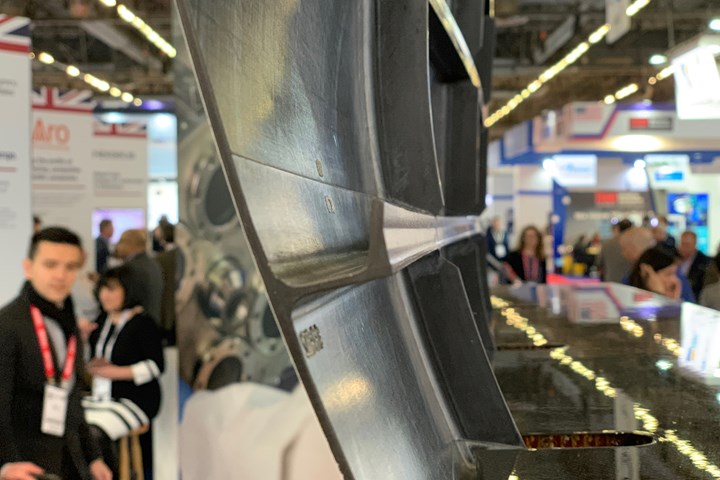From the CW Archives: I see thermoplastics in your future
Thermoplastics are evolving quickly into larger structures and clearly will have a significant role to play in the next commercial aircraft program — whenever that’s announced. This edition of “From the CW Archives” looks back on a thermoplastics pioneer.
GKN Fokker exhibited this demonstrator thermoplastic composite fuselage panel at JEC World 2019. JEC World 2024 featured many more similar panels, signaling the ongoing shift to larger thermoplastics for aerospace applications. Source: CW
At the JEC World 2024 trade show last week (March 5-7) in Paris, I counted five exhibits of demonstrator fuselage panels fabricated using thermoplastic composite materials. The materials and fabricators involved in each spanned the composites industry supply chain and represented, it seems, the ongoing shift the aerospace industry is making toward thermoplastic structures.
Of course, the use of thermoplastics in aerostructures is not a new thing. What’s new is that these structures are getting larger, and the fuselage panels I saw at JEC — replete with integrated stringers — are proof of that. The poster child of this evolution is the Multifunctional Fuselage Demonstrator (MFFD), a Clean Sky project designed to assess the viability of welded thermoplastic composites in a fully integrated fuselage structure. CW has reported extensively on the MFFD over the last few years, with the most intensive provided by Ginger Gardiner in this report from last year: “Manufacturing the MFFD thermoplastic composite fuselage.”
When, where and how thermoplastics might be applied in a commercial aircraft remains to be seen. Neither Boeing nor Airbus seems ready to announce a new program, but when they do, it’s a certainty that larger thermoplastic composite structures will be considered and applied.
All of this reminded me of a couple of things. First, at JEC World 2019, thermoplastic composites specialist GKN Fokker exhibited its own thermoplastic fuselage panel (see photo above) — this one a Gulfstream business jet demonstrator. It featured welded stringers and frames and was a clear harbinger of things to come.
The second reminder was four years before that, in 2015, when CW technical editor Sara Black and I visited Fokker Aerostructures (before it was acquired by GKN) in Hoogeveen, Netherlands, and got to see firsthand the thermoplastic composites manufacturing processes it has developed. In particular, we were shown the fabrication systems Fokker used to produce thermoplastic J-nose structures for the Airbus A380 — pretty large structures in their own right. The report Sara and I wrote about our visit is here: “Plant tour: Fokker Aerostructures: Hoogeveen, Netherlands.”
I hope and expect that we will see these larger thermoplastic structures developed for a new commercial aircraft sometime in the next few years — before 2030, I would think. We’re looking forward to seeing how the composites industry continues to respond.
Related Content
-
JEC World 2024 highlights: Thermoplastic composites, CMC and novel processes
CW senior technical editor Ginger Gardiner discusses some of the developments and demonstrators shown at the industry’s largest composites exhibition and conference.
-
Welding is not bonding
Discussion of the issues in our understanding of thermoplastic composite welded structures and certification of the latest materials and welding technologies for future airframes.
-
Developing repairs for thermoplastic composite aerostructures
HyPatchRepair project proves feasibility of automated process chain for welded thermoplastic composite patch repairs.

















